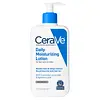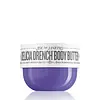What's inside
What's inside
 Key Ingredients
Key Ingredients

 Benefits
Benefits

 Concerns
Concerns

 Ingredients Side-by-side
Ingredients Side-by-side

Water
Skin ConditioningGlycerin
HumectantCaprylic/Capric Triglyceride
MaskingCetearyl Alcohol
EmollientCetyl Alcohol
EmollientPotassium Phosphate
BufferingCeramide NP
Skin ConditioningCeramide AP
Skin ConditioningCeramide EOP
Skin ConditioningCarbomer
Emulsion StabilisingDimethicone
EmollientCeteareth-20
CleansingBehentrimonium Methosulfate
Methylparaben
PreservativeSodium Lauroyl Lactylate
EmulsifyingCholesterol
EmollientDisodium EDTA
Dipotassium Phosphate
BufferingPropylparaben
PreservativeHydrolyzed Hyaluronic Acid
HumectantPhytosphingosine
Skin ConditioningXanthan Gum
EmulsifyingPolysorbate 20
EmulsifyingPolyglyceryl-3 Diisostearate
EmulsifyingWater, Glycerin, Caprylic/Capric Triglyceride, Cetearyl Alcohol, Cetyl Alcohol, Potassium Phosphate, Ceramide NP, Ceramide AP, Ceramide EOP, Carbomer, Dimethicone, Ceteareth-20, Behentrimonium Methosulfate, Methylparaben, Sodium Lauroyl Lactylate, Cholesterol, Disodium EDTA, Dipotassium Phosphate, Propylparaben, Hydrolyzed Hyaluronic Acid, Phytosphingosine, Xanthan Gum, Polysorbate 20, Polyglyceryl-3 Diisostearate
Water
Skin ConditioningButyrospermum Parkii Butter
Skin ConditioningCocos Nucifera Oil
MaskingEthylhexyl Palmitate
EmollientParfum
MaskingMethyl Glucose Sesquistearate
EmollientGlyceryl Stearate Se
EmulsifyingLauryl Laurate
Skin ConditioningGlycerin
HumectantMyristyl Myristate
EmollientHydrolyzed Sodium Hyaluronate
Skin ConditioningLactobacillus/Hibiscus Sabdariffa Flower Ferment Filtrate
Skin ConditioningCopaifera Officinalis Resin
MaskingPassiflora Edulis Seed Oil
EmollientPlatonia Insignis Seed Butter
EmollientTheobroma Grandiflorum Seed Butter
Skin ConditioningSqualane
EmollientTocopherol
AntioxidantBixa Orellana Seed Extract
MaskingCetearyl Alcohol
EmollientBehenyl Alcohol
EmollientCaprylic/Capric Triglyceride
MaskingPhenyl Trimethicone
Skin ConditioningMaltodextrin
AbsorbentCetearyl Olivate
Sorbitan Olivate
EmulsifyingSodium Stearoyl Glutamate
CleansingPotassium Cetyl Phosphate
EmulsifyingSodium Gluconate
Skin ConditioningEthylhexylglycerin
Skin ConditioningPhenoxyethanol
PreservativeButylene Glycol
HumectantCarbomer
Emulsion StabilisingPotassium Hydroxide
BufferingSodium Hydroxide
BufferingCI 75120
Cosmetic ColorantAlpha-Isomethyl Ionone
PerfumingWater, Butyrospermum Parkii Butter, Cocos Nucifera Oil, Ethylhexyl Palmitate, Parfum, Methyl Glucose Sesquistearate, Glyceryl Stearate Se, Lauryl Laurate, Glycerin, Myristyl Myristate, Hydrolyzed Sodium Hyaluronate, Lactobacillus/Hibiscus Sabdariffa Flower Ferment Filtrate, Copaifera Officinalis Resin, Passiflora Edulis Seed Oil, Platonia Insignis Seed Butter, Theobroma Grandiflorum Seed Butter, Squalane, Tocopherol, Bixa Orellana Seed Extract, Cetearyl Alcohol, Behenyl Alcohol, Caprylic/Capric Triglyceride, Phenyl Trimethicone, Maltodextrin, Cetearyl Olivate, Sorbitan Olivate, Sodium Stearoyl Glutamate, Potassium Cetyl Phosphate, Sodium Gluconate, Ethylhexylglycerin, Phenoxyethanol, Butylene Glycol, Carbomer, Potassium Hydroxide, Sodium Hydroxide, CI 75120, Alpha-Isomethyl Ionone
 Reviews
Reviews

Alternatives
Ingredients Explained
These ingredients are found in both products.
Ingredients higher up in an ingredient list are typically present in a larger amount.
This ingredient is an emollient, solvent, and texture enhancer. It is considered a skin-softener by helping the skin prevent moisture loss.
It helps thicken a product's formula and makes it easier to spread by dissolving clumping compounds.
Caprylic Triglyceride is made by combining glycerin with coconut oil, forming a clear liquid.
While there is an assumption Caprylic Triglyceride can clog pores due to it being derived from coconut oil, there is no research supporting this.
Learn more about Caprylic/Capric TriglycerideCarbomer is a polymer of acrylic acid. Its main role is to create a gel consistency.
A high amount of carbomer can cause pilling or balling up of products. Don't worry, most products contain 1% or less of carbomer.
Cetearyl alcohol is a mixture of two fatty alcohols: cetyl alcohol and stearyl alcohol. It is mainly used as an emulsifier. Emulsifiers help prevent the separation of oils and products. Due to its composition, it can also be used to thicken a product or help create foam.
Cetearyl alcohol is an emollient. Emollients help soothe and hydrate the skin by trapping moisture.
Studies show Cetearyl alcohol is non-toxic and non-irritating. The FDA allows products labeled "alcohol-free" to have fatty alcohols.
This ingredient is usually derived from plant oils such as palm, vegetable, or coconut oils. There is debate on whether this ingredient will cause acne.
Due to the fatty acid base, this ingredient may not be Malassezia folliculitis safe.
Learn more about Cetearyl AlcoholGlycerin is already naturally found in your skin. It helps moisturize and protect your skin.
A study from 2016 found glycerin to be more effective as a humectant than AHAs and hyaluronic acid.
As a humectant, it helps the skin stay hydrated by pulling moisture to your skin. The low molecular weight of glycerin allows it to pull moisture into the deeper layers of your skin.
Hydrated skin improves your skin barrier; Your skin barrier helps protect against irritants and bacteria.
Glycerin has also been found to have antimicrobial and antiviral properties. Due to these properties, glycerin is often used in wound and burn treatments.
In cosmetics, glycerin is usually derived from plants such as soybean or palm. However, it can also be sourced from animals, such as tallow or animal fat.
This ingredient is organic, colorless, odorless, and non-toxic.
Glycerin is the name for this ingredient in American English. British English uses Glycerol/Glycerine.
Learn more about GlycerinWater. It's the most common cosmetic ingredient of all. You'll usually see it at the top of ingredient lists, meaning that it makes up the largest part of the product.
So why is it so popular? Water most often acts as a solvent - this means that it helps dissolve other ingredients into the formulation.
You'll also recognize water as that liquid we all need to stay alive. If you see this, drink a glass of water. Stay hydrated!
Learn more about Water